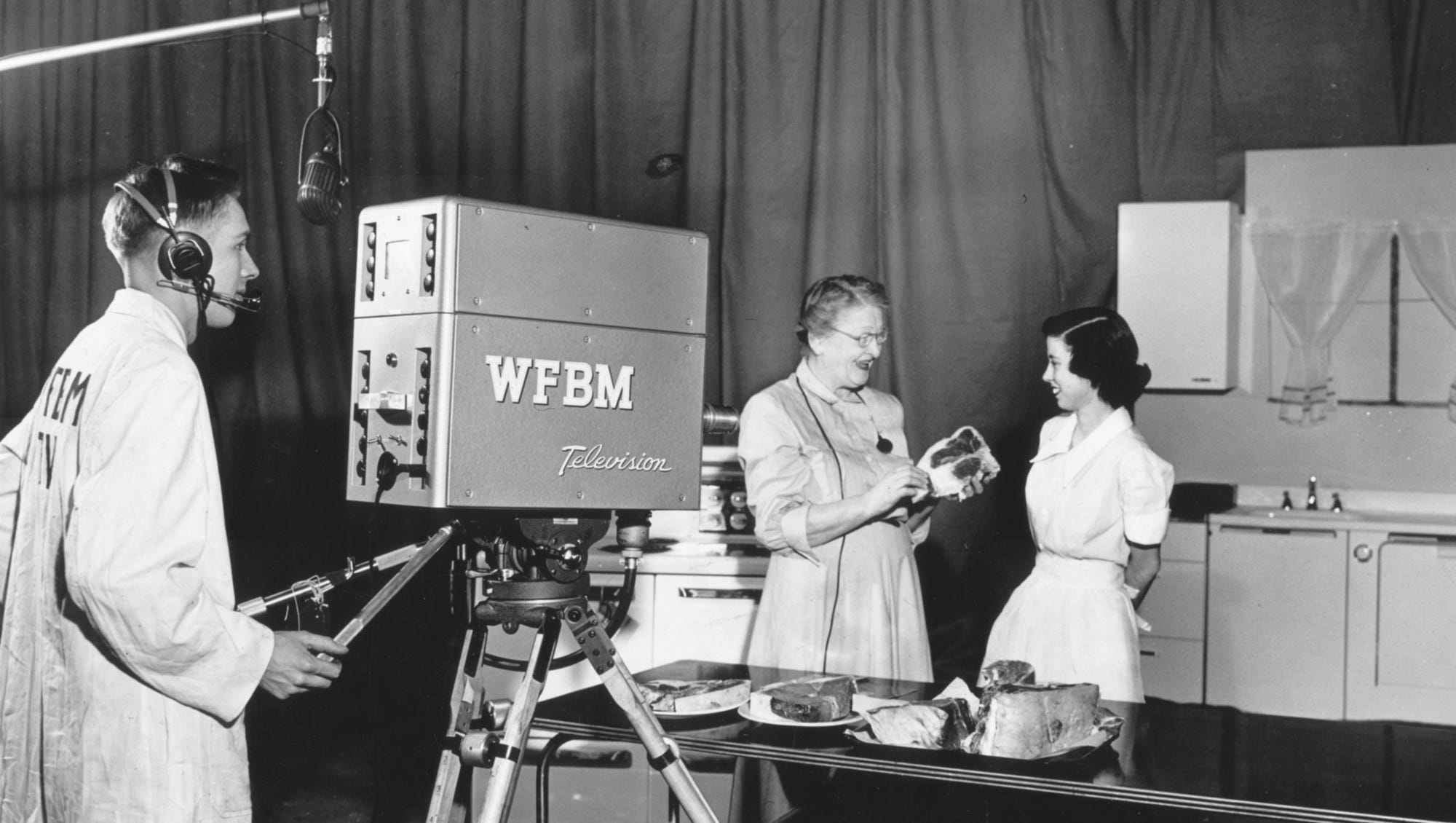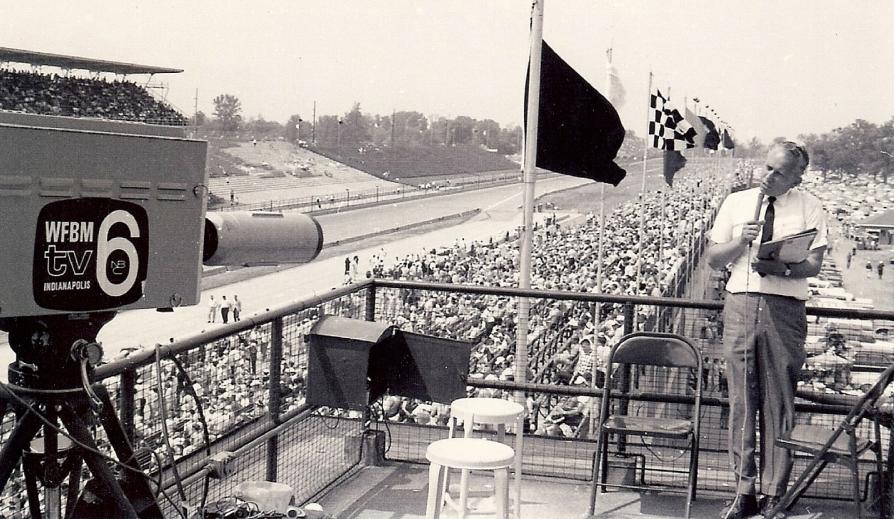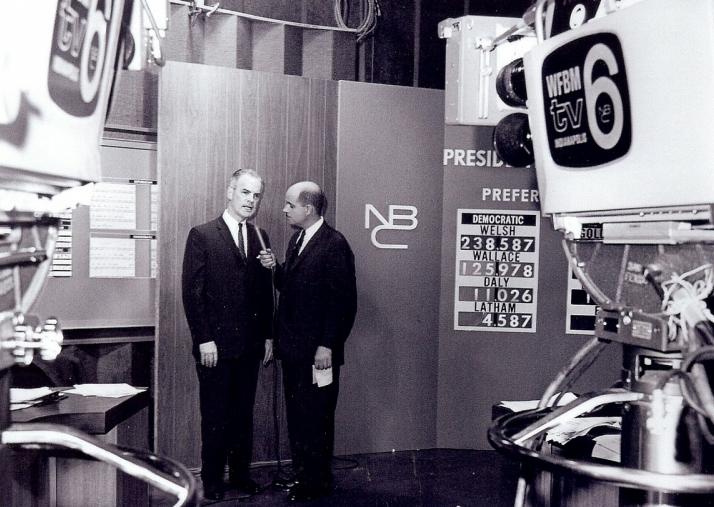Consolidated Television and Radio Broadcasters, Inc., parent of WFBM radio and headed by Harry M. Bitner Sr., of Pittsburgh, received approval from the Federal Communications Commission (FCC) in early 1948 to establish Indianapolis’ first commercial television station. It operated as Channel 6 on the television spectrum.

By March 1949, the company was promoting the advent of the new medium and encouraging the purchase of television receivers through demonstrations at the Indiana State Fairgrounds.
Transmitting from a 228-foot-tower atop the , WFBM-TV first aired at 10 A.M. on May 30, 1949, with “Crucible of Speed,” a half-hour history of the , followed by a live broadcast of the . Regular programming began later that evening with “TeleNews,” a newsreel compiled by the International News Service, cartoons, “People’s Platform” and “Kobb’s Korner,” and an hour-long Columbia Broadcasting System (CBS) variety show, “54th Street Revue.”

As the city’s premier television station, WFBM claimed numerous local “firsts.” During the summer of 1949, WFBM telecast several baseball games from . In mid-1950, it hired as the city’s first TV weatherman.
WFBM also broadcast a series of 10 concerts beginning in December 1951. WFBM teamed with to televise the first coast-to-coast sporting event from Indianapolis on May 28, 1952—a welterweight boxing match pairing Kid Gavilan and Fitzie Pruden at the Fairgrounds Coliseum. That same year, WFBM joined with Life magazine to broadcast “Life Goes to School,” a series of reports on Marion County schools. The fall of 1952 brought early efforts at religious broadcasting and the city’s first televised election coverage, headed by .
The station, which soon built a new facility at 1330 North Meridian Street, obtained permission in 1953 to erect a new tower and transmitter on the city’s far northside, enabling it to broadcast at the maximum power allowed by the FCC. WFBM aired programs that originated from the national networks, were filmed off the television screen, and flown to Indianapolis from New York. The completion of a series of microwave relay towers in the mid-1950s allowed the station to receive direct network broadcasts.
WFBM began its network affiliation in 1950 with CBS. When WISH-TV Channel 8 dropped its American Broadcasting Company (ABC) affiliation in September 1954 and switched to CBS, WFBM signed an agreement with the National Broadcasting Company (NBC), a relationship that continued until 1979.

By 1956, Bitner had agreed to sell the WFBM radio and television stations to Crowell-Collier Publishing Company in a $16 million package that would have included stations in Minneapolis, Grand Rapids, and Flint, Michigan. After Crowell-Collier withdrew its offer, Bitner began negotiations with Time, Inc. (later Time-Life, Inc.), and concluded a $15.75 million sale in 1957.
WFBM expanded its broadcasting capabilities throughout the 1960s and began color programming in 1967. Its documentary, “The Negro in Indianapolis,” broadcast in the fall of 1969, earned the coveted Peabody Award in 1970. Barbara Boyd also joined the WFBM news staff in 1969 as a consumer reporter, becoming the first African American woman in Indianapolis to appear on television as a journalist. She became a well-known and influential newswoman who worked at the station for 25 years.

McGraw-Hill publishers acquired WFBM in 1972 and changed the call letters to WRTV since FCC regulations prohibited cross-ownership of cable and broadcast television stations in the same market. The sale was part of a $57 million package, which included sister stations in Denver, San Diego, and Bakersfield, California. The deal also prescribed unprecedented programming, employment, and training for minority individuals.
By the late 1970s, NBC was the lowest-rated national television network, while ABC had risen to the top. The ABC network sought out stronger local stations for affiliation, which led it to approach WRTV. The station severed its ties with NBC in 1979 and joined ABC, justifying its move by stating that ABC’s “total commitment to news” was “tremendously important” to its goals.
WRTV was the first in Indianapolis to have partnered with all three heritage broadcast networks (WTTV would become the second when it became a CBS affiliate in 2015). Only a few television stations across the nation have served as a primary affiliate of ABC, CBS, and NBC.

WRTV won a local CASPER Award for public service in 1989 for its documentary on police and community relations. The station has also produced the award-winning program “At the Zoo,” in conjunction with the . In 1993, WRTV began a half-hour newscast at 10 PM on WTTV Channel 4 after that station eliminated its own news department. In 1994, longtime news anchor retired. During his 35 years at the station, news programming expanded from a 10-minute early-evening segment to a 90-minute evening newscast and other news broadcasts throughout the day.
In the late 1990s, WRTV was the first Indianapolis television station to launch a website (theindychannel.com), and it became the first to launch one in mobile format (6News OnTheGo) in the early 2000s. At the end of 2011, McGraw Hill sold its seven-station broadcasting service, which included WRTV, to E. W. Scripps broadcasting company for $212 million.
WRTV partnered with in 2012 to open a secondary facility at the studios of news-talk radio station . The station’s agreement with Emmis included renovations at Emmis headquarters on to accommodate local news production. Since then, most WRTV newscasts have been broadcast from these downtown studios. In return, WRTV has provided news content for WIBC. Some staff appear on both stations.
At WRTV’s North Meridian studios, Scripps expanded an existing regional control system that McGraw Hill had built to create a centralized regional broadcasting hub. In 2014, these WRTV studios became the center of master-control operations for Scripps’ 19 television stations.
In 2018, Scripps renewed its affiliation agreement with ABC for WRTV.

Help improve this entry
Contribute information, offer corrections, suggest images.
You can also recommend new entries related to this topic.